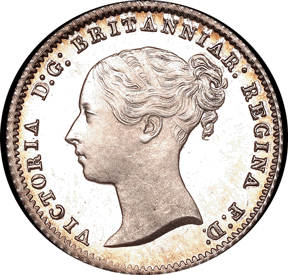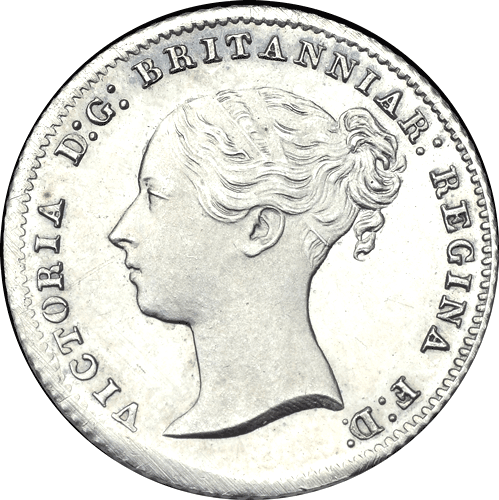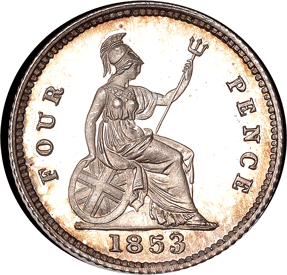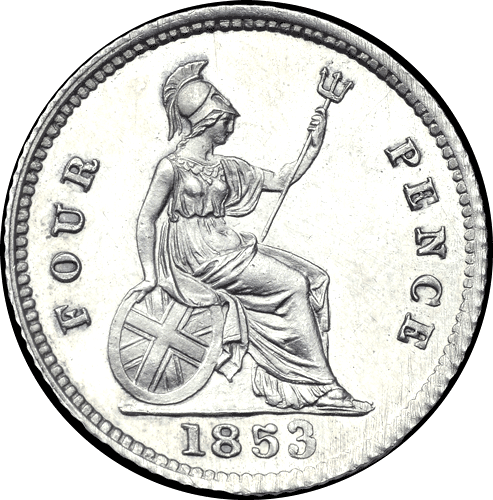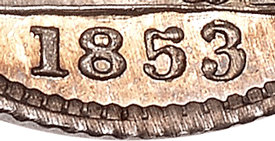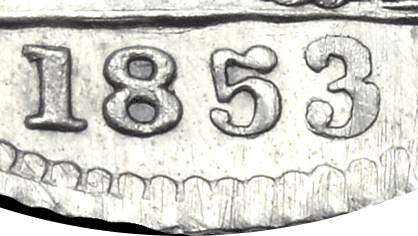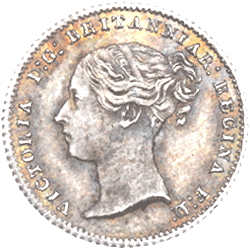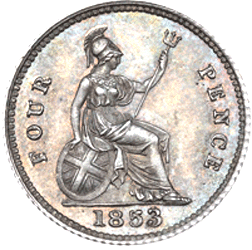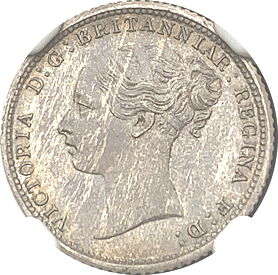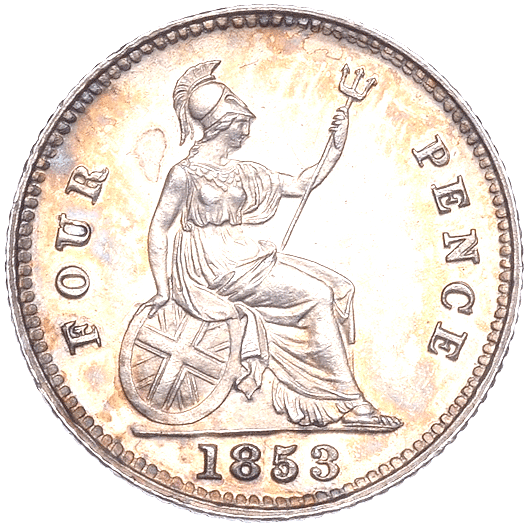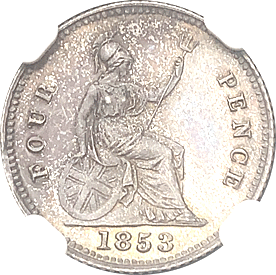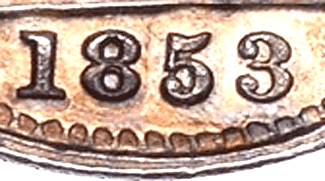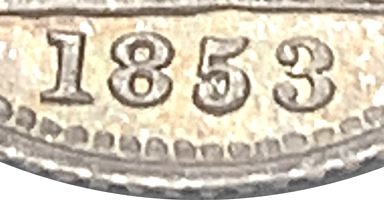|
Michael Coins Ltd |
![]() Other Lists
Other Lists
COIN CLUB
1853 Groats: Obverse & Date varieties
1853 Groats (proof)
1853 groats are Extremely Rare and according to auction records I can only
find details of proofs examples having been offered for sale. I will give my
opinion on the currency issue after showing my take on the proof issue.
* The amount of 1853 proof sets is unknown and possibly for a very good reason as it
appears that these sets were made and given to (visiting ?) VIP's well in to the mid 1880s !
That fact has never been recorded. How can we be certain that happened ?!
The discovery of the 1853 proof groats with the Obverse dies 3 & 4 of the currency series
should confirm this observation.
|
|
|
|
|
GR 1853 P - obv. 1 |
GR 1853 Pa - obv. 1 |
|
|
|
|
|
GR 1853 P - Rev. |
GR 1853 Pa - Rev. |
|
|
|
|
|
GR 1853 P - Date (A) |
|
GR 1853 Pa - date (Aa) |
GR 1853 P - Obv. 1 - Proof As used from 1838 to 1855
First I of VICTORIA to gap. Top of ear is showing.
Date: A - The 3 appears to be a very slightly larger numerals than the 185
The 5 - the top has a large bulbous rounded end.
The back bar of the 5 leans slightly backwards.
The circular gap in the lower half in large and the front is 'puffed' up.
The 3 is large and the top does not curve down as much making
it a more open top 3. The centre bar is short.
GR 1853 Pa - Obv. 1 - Proof (As per Type P) but the die is now worn out and rim and border
teeth from 5 to 8 o'clock are missing and the rim worn from 8 to 11 o'clock.
First I of VICTORIA to gap. Top of ear is showing. (As per Type P1).
Rev. - (As per Type 1) but the die is now worn out and rim and border teeth
from 2 to 7 o'clock are missing.
Date: Aa - The 3 appears to be a very slightly larger numerals than the 185
The 5 - the top has a large bulbous rounded end.
The back bar of the 5 leans slightly backwards.
The circular gap in the lower half in large and the front is 'puffed' up.
The 3 is large and the top does not curve down as much making
it a more open top 3. The centre bar is short.
The rim and border teeth in this area are also very weakly stuck.
Another example of 1853 Proof Groat with obverse 1
|
|
|
|
|
GR 1853 P - Obv. |
|
GR 1853 P - Rev. |
* Approximately 8 x 1853 Groat (Obv. 1 + Rev & date A) have been noted in
sale auctions from 2005. All have been with a milled edge.
No plain edge examples have been offered for sale, that I can find.
Only 1 x 1853 Groat (Obv. 1 + Rev & date Aa - struck from worn dies)
has been offered for sale since that time.
My thank to B. P. for advising me that he has in his collection an 1853 Groats with
(Obv. 1 + Rev. & date Aa).
GR 1853 P - One coin has the normal (medal) axis strike ↑↑
GP 1853 P1 - Another example with (coin) axis strike ↑↓
None of the reference books refer to any of the "proof" groats having been issued
with a (coin) axis strike ↑↓ therefore this example must be considered extremely rare l
No 1853 Groats with obv. 2 have been seen.
* If all of the 1853 Groats had been made or struck in 1853
then they would have been produced with Obverse 1
(Used from 1838 to 1861) but, below, I will show examples
that have been found and sold with the following two
later obverses - obverse 3 & 4. As suggested at the top
of this page these coins were made in the late 1860's
and into the 1880's for adding to the 1853 proof sets
now that obverse dies were no longer usable or available.
Obverse 3 (Used from 1866 to 1879)
Obverse 4 (Used from 1880 to 1887)
For differences between Obverse 3 & 4 see this link
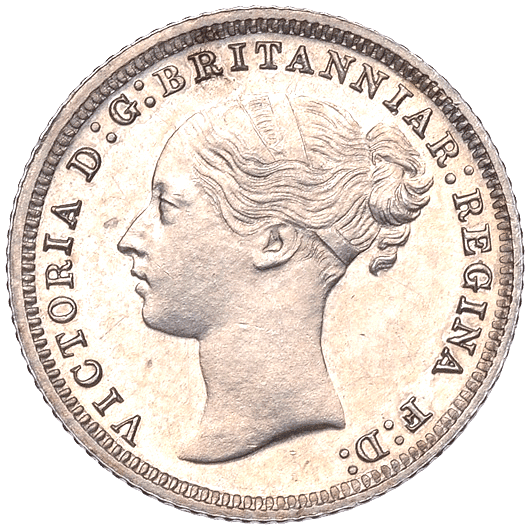 |
|
|
| GR 1853 S - Obv. 3 |
GR 1853 T - Obv. 4 |
|
|
|
|
|
GR 1853 S - Rev. |
GR 1853 T - Rev. |
|
|
|
|
|
GR 1853 S - Date (B) |
GR 1853 T- Date (B) |
GR 1853 S - Obv. 3 There are now many more border teeth and
Victoria's bust is now slightly larger and in lower relief.
Her mouth is fuller and her nose slightly more pronounced.
The back of the truncation is smoother and less sharp.
Victoria's hair still covers the top of her ear.
The first I of VICTORIA now points to a border tooth.
Rev. Is the same type as used from 1838 to 1853 - only the date differs.
The rim and border teeth are very strong and well struck.
Date B: The numerals appear to be of similar size.
The 5 - the top is slightly concave and the front is pointed sloping upwards
The 5 - the back bar tilts ever so slightly forward and the circular gap
in the lower half is fairly small.
The 3 - The top part now curls downwards to leave but a very small gap
to the to the tip of a long centre bar.
Both the top and tail end have a bulbous end.
GR 1853 T - Obv. 4 Victoria's bust as well as the legend have been altered.
Bust: Victoria's young head portrait for obverse 4 has remained as similar
to obverse 3 as possible. Her eye is in slightly stronger focus. Her nostril
has been re-instated. Slightly more of the top of her ear has been exposed.
Her hair has been re-engraved to be sharper than before and this time it
looks natural. The two hair ribbon at the top of her hair have lost the tiny
raised lines to either side of the ribbon and the ribbons are now flat.
Victoria has been given a few more hairs at her nape. Her "Bun" hair has
been re-cut with many fine lines. The 'tail' to her 'Bun' now has an outward
curl. The front tip of her truncated neck now curves downwards instead of
forward. The colon dots after D : are now further in, below Victoria's neck.
Legend: Leg of R of RIA to tooth; I of RIA to gap; A of RIA to tooth. larger.
Larger gap between A of VICTORIA & D: of D: G:
Colon dots after G : wider.
Less border teeth.
Rev. Is the same type as used from 1838 to 1853 - only the date differs.
The rim and border teeth are very strong and well struck.
Date B: The numerals appear to be of similar size.
The 5 - the top is slightly concave and the front is pointed sloping upwards
The 5 - the back bar tilts ever so slightly forward and the circular gap
in the lower half is fairly small.
The 3 - The top part now curls downwards to leave but a very small gap
to the to the tip of a long centre bar.
Both the top and tail end have a bulbous end.
* All 1853 Groats with either obverse 3 or 4 have only been found with
only date type B (pointed end to the top bar). One can only conclude
that the earlier reverse with Date type A was no longer available and
that a new reverse and date die needed to have been made.
1853 Currency coin
It has been recorded, according to Royal Mint records, that a very small mintage of 11,880 coins
were made for currency use in 1853. It is possible that some or all of that mintage were made after
striking the proof issue coins using the die dated 1853 obverse die P1a and the remainder with the
1852 die which was not greatly over used as it also has a fairly low mintage of 31,300 coins struck.
If 1853 currency coins were struck then they are extremely are and very rarely turn up.
These are the only examples of "possible" 1853 currency coins that have been brought to my
attention by (J.F.2021). These two coins were sold in the DNW sale of 14 June 2017 - Lot 338
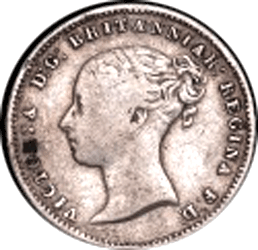 |
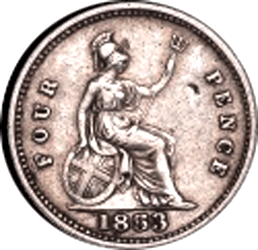 |
|
| GR 1853 A - 1st example | GR 1853 A - 1st example | |
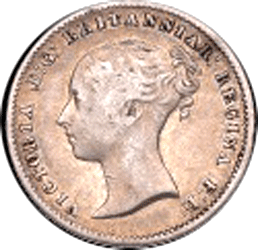 |
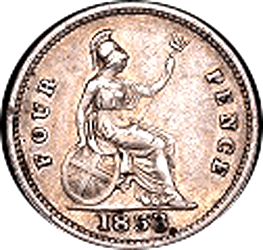 |
|
| GR 1853 A - 2nd example | GR 1853 A - 2nd example |
I regret that the images are not as sharp as I would like but finding examples of
possible 1853 currency groats are difficult.
These coins could well be proof 1853 Groats that got used and found their way
into currency use. If these TWO coins are with obverse 1 then their use as currency
coins is possible. However, if they are with obverse 2 then they are most certainly
NOT official currency issued coins as that die was not used until 1859 at the earliest !
If anyone has any further information that they can share on this
date I will be pleased to hear about it.
"English Silver Coinage" (ESC) lists Ref: 3350 - Date: 5 over 3.
This variety seem VERY unlikely (No image shown !).
| Back to Groats |
